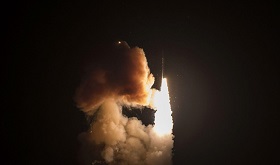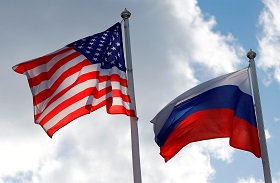Imagine an ordinary everyday situation, which shouldn’t be a problem this summer with its unpredictable weather. You were going to spend the weekend outside, but looking out the window on a Saturday morning you’re appalled to see the sky overcast with leaden clouds, frequent flashes of lightning on the horizon and to hear the approaching roar of thunder. Indeed, the weatherman warned of cloudy skies with a chance of rain in yesterday’s report, but you hoped that the rain would fall elsewhere. But Murphy’s Law again... and the rain hits your area.
You have several options, including two extreme solutions. You can call the mayor’s office, the government or the presidential executive office and demand to scramble a dozen aircraft to disperse the clouds. Or you can try to talk yourself into believing that you didn’t really want to slog through congested traffic to some nondescript location in the middle of nowhere. It would be much more pleasant to spend the weekend lying on the couch watching TV, drinking beer and snacking on chips.
That’s about how the approaches of Russian analysts were divided a year ago, when light clouds in the area of arms control turned into an actual storm, that is, when the theoretical prospect of the Trump administration’s withdrawal from the INF Treaty became a political reality. Those who advocated saving the treaty at any cost and by any means found themselves at one extreme. The proponents of the INF Treaty said terminating it would result in a multitude of grave ramifications, like triggering a new arms race, undermining strategic stability in Europe and internationally, and lead to a chain reaction where the rest of the bilateral and multilateral treaties in the sphere of security would be thrown out.
Overt or covert critics of the treaty are at the other end of the spectrum. They believed that the INF Treaty was at odds with Moscow’s interests even when it was signed in late 1987 and was a major mistake by Mikhail Gorbachev and Eduard Shevardnadze, as it provided significant unilateral advantages to the United States. In the 30 years that have elapsed since its signing, the INF Treaty has by and large become hopelessly obsolete, especially given the build-up of arsenals of intermediate and shorter-range missiles by third countries near Russia’s borders. So, the termination of the treaty should not be overly dramatized. In some ways Russia will lose, but in others it will benefit, especially given the presence of advanced domestic achievements in creating carriers in this range.
As far as we can see, Russia’s official policy turned out to be the lowest common denominator between these diametrically opposed viewpoints. Of course, there is no reason to put all our faith in the memoirs authored by former US national security adviser John Bolton who claims that, in a conversation with him, Defence Minister Sergei Shoigu allegedly admitted that the INF Treaty had “lost its practicality.” Russia’s position on the treaty is well known and is devoid of ambiguity. Nevertheless, one gets the impression that Moscow was not fighting to preserve the INF Treaty as consistently, resourcefully or energetically as it fought to preserve the ABM Treaty two decades earlier. In all likelihood, Moscow was no longer sure the rain clouds could be effectively dispersed in 2019. Truth be told, there was no way to disperse the clouds in 2001 ̶ 2002, either. Despite Moscow’s efforts and the international community’s support, the George W. Bush administration had nevertheless withdrawn from the ABM Treaty and launched the process of tearing down the bilateral model of strategic stability.
The past year failed to clear up the disputes between advocates and detractors of the INF Treaty. It’s not that immediately after the US had withdrawn from the INF Treaty the world found itself on the brink of a nuclear war, nor did an uncontrolled nuclear arms race immediately begin in Europe. Mitigating the fallout of the Trump administration’s withdrawal from the treaty, the US Congress, in the adopted defence budget for 2020, prudently barred the Pentagon from acquiring and deploying new ground-based intermediate and shorter-range missiles.
However, the alarmists were correct when they claimed that a chain reaction that would dismantle the old strategic stability system would receive an additional powerful impetus.
In May 2020, the White House announced its decision to withdraw from the Open Skies Treaty. With each passing month, the chances for extending the New START Treaty were becoming increasingly slim. Rumours had it that the United States might resume nuclear testing and unilaterally revise its commitments under the Missile Technology Control Regime (MTCR). Given these circumstances, many politicians and analysts welcomed the postponement of another Review Conference of the Parties to the Treaty on the Non-Proliferation of Nuclear Weapons (NPT) from spring 2020 to spring 2021 as the conference could have become an epic failure.
Admittedly, the developments of recent months have everyone’s attention. Previously, the focus, albeit not particularly strong, was on arms control. The outbursts of violence in Syria and Libya, an abrupt and unexpected drop in global oil prices, which triggered the global recession, exacerbated US-China differences and, finally, the coronavirus pandemic came as more significant political developments than the termination of the INF Treaty or the prospect of the New START expiring without being renewed. Over the past year, the leaders’ priorities in the United States and Russia have been increasingly shifting towards domestic problems and challenges. The lacklustre demise of the INF Treaty was increasingly perceived not as a tragic failure of a well-functioning system, but as an historical inevitability and another chapter in the long and sad chronicle of destroying the foundations of global strategic stability. Not the first chapter, but certainly not the last, either.
Today, a year after the United States withdrew from the INF Treaty, it is becoming increasingly clear that the old world order is gone for good. Even if the political clouds are miraculously dispersed and the New START is revived in the coming months, it would not do much to bring back the Soviet-American model of arms control that took shape almost half a century ago. We believe the faint hopes that Joe Biden’s likely victory in the November election will drastically change things for the better have no real foundation, because Washington’s political relations with Moscow and Beijing under a President Biden would not be conducive to achieving any breakthrough agreement in the security sphere. In addition, it is easy to predict that the United States will remain a deeply divided state after the November election, which will significantly complicate any concerted US approach to arms control.
As the great American economist John Kenneth Galbraith aptly noted, in politics the choice is usually not between good and bad, but between unpleasant and disastrous. It would, of course, be nice to scramble planes to disperse the thickening clouds and restore in full the past achievements of arms control, including the INF Treaty, ABM, TOS and CFE and also to reiterate the enduring value of the New START, NPT, MTCR, CTBT, etc. However, waiting for the rescue aircraft to appear in the sky might take a long time; today’s politicians are simply not motivated enough to burn scarce political kerosene in order to disperse thunderclouds.
There are too many other problems and concerns, including the economic crisis, climate change, international migration and the fallout of the coronavirus pandemic. Arms control, alas, has long lost its former status as the centrepiece of international politics, and we will need to come to grips with this fact one way or another.
But lying on the couch with a can of beer and a bag of chips pretending that we “didn’t really want to” and that we would do just fine without any arms control is not the best approach, either. The temptation of “nuclear sovereignty,” “strategic autonomy” and even “strategic isolationism” without any restrictions whatsoever is certainly strong for any nuclear power. For some players, it’s about hope to win an uncontrolled arms race using a superior resource base or technology. For others, it’s an opportunity to guarantee the effectiveness of an “asymmetric” retaliatory strike in a hypothetical scenario of a nuclear clash. For others, it’s hopes to at least partially neutralise the unfavourable ratio of nuclear potential by retaining the “strategic uncertainty” situation with regard to their capabilities and plans. However, these hopes, opportunities and calculations are nothing more than a mirage and an ephemeral illusion. The old maxim that one cannot ensure one’s own security at the expense of the security of others, for all its triviality, remains true in the 21st century. An uncontrolled arms race is not only about ever-increasing material costs, but also ever-increasing risks.
If you can’t disperse the clouds and are tiring of lying on the couch, it’s time to start looking for an umbrella.
To be able to embrace the future with confidence, the nuclear countries’ leaders first need to admit their mistakes and delusions of the recent past. History was generous enough to give the five nuclear powers 30 years to find a formula for transitioning from the old bipolar model of strategic stability of the 20th century to a new multilateral model of the 21st century that suits everyone. However, these 30 years were, in fact, wasted. Now, the old model of stability is rapidly and irreversibly collapsing, while the new model has yet to be seen even in the most general form. The world is entering the twilight zone. It is no longer an isolated rainy day of a sunny summer, but the onset of a long rainy season. For many reasons of a geopolitical, organisational, technical and even psychological nature, most likely, it will not be possible to agree on, sign and ratify new “classic” arms limitation treaties in the coming years.
The approximate design of an umbrella for the nuclear powers is not too complicated. It includes expanding the channels of communication between the military at all levels, exchanging information about their nuclear missile forces, strategic doctrines and modernisation plans, concurrent measures to reduce the level of a missile systems’ combat readiness, the beginning of meaningful consultations on the most dangerous military technologies, and joint actions against the threat of nuclear terrorism and nuclear proliferation. By opening this umbrella, the five nuclear powers could not only mitigate risks and cut the costs of an unavoidable next round of an arms race, but also gain experience in working in a multilateral format and create at least minimal trust that is critically important for addressing more ambitious tasks in the nuclear sphere.
First published in the Valdai Discussion Club.







